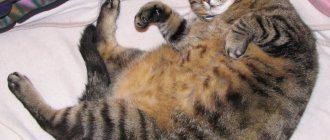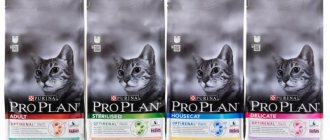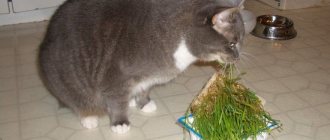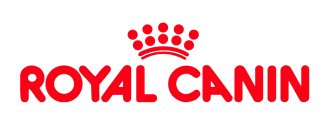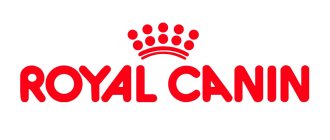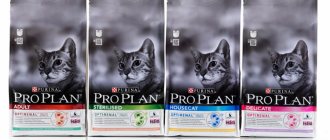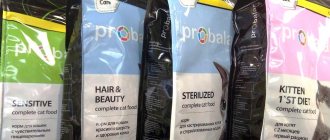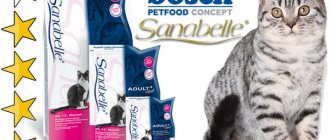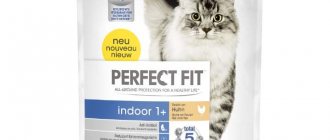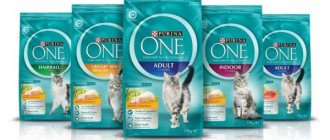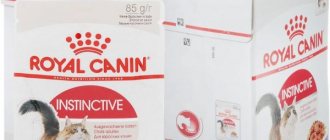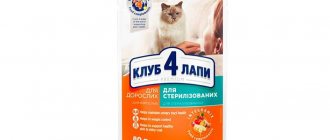After castration and sterilization, male cats become calm and affectionate. They do not mark territory, do not look for a partner for mating, and do not experience stress from the inability to satisfy their sexual instinct. For animals to be healthy, they must eat properly. The question arises: what is the difference between food for sterilized cats and regular food? When preparing a diet, veterinary nutritionists take into account the level of physical activity, metabolic rate and the needs of the animal whose gonads have been removed.
Features of nutrition of sterilized cats
Owners need to know what happens to their pet’s body after surgery. This will help you understand how important it is to feed the animal with high-quality specialized industrial diets.
After surgery, hormonal levels change. Females stop producing estrogens, which are responsible not only for sexual desire, fertilization and maintenance of pregnancy, but also for satiation with food. If these hormones are not produced, the pet overeats. This threatens excess weight, diabetes, urolithiasis (KD), and heart problems.
The cat's gonads (testes) produce testosterone. Male hormones are responsible for sexual desire and nutrient absorption. Their absence leads to the deposition of subcutaneous fat. If the diet is not adjusted properly, a neutered cat may become obese. Excess weight often causes cystitis, urolithiasis, kidney failure and diabetes.
A pet's health depends on its physical activity. Castrated and sterilized animals move little and rarely play. They sleep more and cuddle in the arms of their owners. To prevent physical inactivity from causing obesity, you need to play a lot with cats and cats and adjust their diet.
Cats and cats have a high risk of developing urolithiasis. Sterilization itself does not cause bladder stones. The disease appears against the background of excess weight. Stones are also formed due to excess minerals. Therefore, it is important that the diet is balanced.
The difference between food for sterilized animals is the reduced content of nutrients such as:
- crude oils and fats;
- carbohydrates;
- minerals (calcium, phosphorus and magnesium);
- ash (mineral residue).
Commercial diets often include sea buckthorn and cranberries. The berries acidify alkaline urine, support the health of the urinary system, and prevent the formation of crystals and stones.
It is not advisable to feed your pets homemade food.
It is difficult to balance it on your own. Industrial feed meets the necessary standards. They are the prevention of diseases, including obesity. This rule applies only to high-quality food that belongs to the premium, super-premium and holistic classes.
Spayed and neutered cats should drink plenty of fluids. It is recommended to place several bowls of clean water around the house, as some animals like to drink in different places.
What about “straight”?
What to do if before the operation the animal got used to “natural food”?
In this case, is there a need to transfer a castrated cat to specialized industrial food - or is it enough to control portion sizes and, perhaps, adjust the menu as a whole? This is an important point, especially considering the fact that high-quality cat food can hit your wallet much harder than purchasing some ordinary products with a four-legged family member in mind.
Another advantage of natural homemade food, besides the savings, is that you always know exactly what you are giving your cat and have complete control over its nutrition in terms of quality and freshness. There is, in essence, only one minus - “natural” requires some trouble.
Natural food for sterilized cats is not contraindicated, but on the contrary, it is recommended - subject to the general rules of nutrition. That is, do not add salt or season with “human” spices; if meat or fish - then low-fat varieties and cuts; if dairy products - then, again, with low fat content; don’t forget about carbohydrates and fiber - it can be fresh grass, or it can be cereals in the form of porridges (except semolina and oatmeal).
Why do you need special food?
Cats and cats are obligate carnivores. In nature, they eat insects, small birds and rodents. The victims' stomachs contain small amounts of fruit, vegetables, grains or grass. Therefore, the diet of cats and cats consists not only of meat.
The main nutrient is animal protein. However, the diet should also contain carbohydrates, fiber, and fats. At home, pets are unlikely to eat cranberries, apples or oats. And in the feed these components are present in the required quantities.
Spaying and neutering increases the risk of obesity, urolithiasis and diabetes.
Specialized nutrition can prevent these diseases. The food for castrates contains a moderate amount of fat (10-12%), so the animal is less at risk of gaining excess weight.
Special food is needed to prevent stones, crystals and sand in the bladder. It contains sodium, which helps cats and kittens consume more fluid.
The amount of magnesium, phosphorus and calcium is reduced. However, the main thing is their correct ratio. This is why industrial diets have been developed. The owner does not need to worry that his pet will not receive enough vitamins and minerals, while other substances will enter the body in excess.
The diet for adults is different from the diet for kittens, even if both are spayed or neutered. Pets under 1 year of age are given kitten food. It contains more vitamins and minerals. This can be harmful to adult animals. Therefore, food for castrates can be given only after reaching 12 months.
Protein
We will never tire of repeating: the basis of the diet of any predator should be animal proteins. The better the protein source, the better the food. High-quality or low-quality protein? Of course, high quality! It is better absorbed. The idea of low protein quality may be suggested by a vague indication of animal protein components in the diet.
But another question: quality or quantity? What to do with food that has a lot of protein, but is of low quality? You should think about whether you should give such a product to your animal. It may be worth considering another food, where the top five includes several decent meat, fish or poultry products. It is especially good if the manufacturer indicated their share in the product on the label.
You can also read about the quality and digestibility of protein here.
Composition of specialized feed
Commercial diets for spayed and neutered animals are produced by different companies. To make the right choice for your pet, it is important to understand how food differs and what they are depending on the composition. Not all products labeled “for castrated” are equally beneficial.
Depending on the composition, specialized dry diets are divided into classes such as:
- Economy Low quality feed contains no more than 4% processed meat products (bones, feathers, skin, beaks). The remaining ingredients are soy, wheat and corn. There are harmful preservatives, taste and smell enhancers. This diet can lead to health problems.
- Premium Medium-level products contain up to 30% meat and offal (skin, liver, lungs). The remaining ingredients are soy and grains. Nutrients and minerals are balanced. Premium food contains artificial preservatives, flavors and taste enhancers. However, compared to economy-class products, premium diets contain meat and do not harm animals. They can be used on an ongoing basis for lack of a better alternative.
- Super premium. This is high quality food. Super premium food contains up to 60% meat ingredients (fillet, lungs, liver, hearts, stomachs). There are no odor or taste enhancers. Instead, chicken fat is used to process the croquettes. The food is preserved using a natural preservative (vitamin E). The composition is completely balanced. This is one of the best food options for obligate castrated or sterilized predators.
- Holistic. This is the highest class of feed. They do not contain grains (wheat, corn, rice). A few legumes are allowed. The amount of meat ingredients reaches 70%. Holistic nutrition is considered the best option for maintaining optimal body weight and preventing disease.
The higher the feed class, the lower the daily requirement. Feeding economy-class products is more expensive than using premium or super-premium food. To be satisfied with economy class food, an animal needs 80-100 g per day. The daily norm for a quality product is 40-50 g.
The optimal number of meals is 2 or 3. The daily intake depends on weight and is indicated on the original packaging.
Owner reviews
Tatiana S.
My bull terrier is allergic. It took me a long time to find out what foods caused the rash on my stomach. The veterinarian advised me to switch to premium food. I bought different ones, he didn’t eat some foods, and his allergies intensified to others. I stopped holistically and have not had any skin problems for more than a year.
Vitaly. U
At the family council they decided to sterilize our Jessica. The operation was almost painless. She lay down for a day, and the next she ate and went for a walk. The dog is one year old and we fed her regular food from the table, but the doctor advised us to change her diet. We chose premium food and did not regret it, Jessica is healthy.
Choosing dry food
Veterinarians recommend choosing 1 food and giving it to your pet on an ongoing basis. Canned food is used as treats. You can't change food often. The animal's digestive tract adapts to one type of nutrition. Industrial dry diets from different manufacturers contain different amounts of proteins, fats, carbohydrates, fiber, etc. Frequent changes in special nutrition can negatively affect the digestion process.
When choosing dry food you need to pay attention to:
- compound;
- mineral ratio;
- best before date;
- integrity of the packaging.
For feeding cats and kittens, it is better to purchase products of at least super-premium class. Premium diets are also suitable as they provide a balance of minerals and nutrients. However, their daily intake is 10-20 g more than holistic or super premium feeds.
What is sterilization
Sterilization or castration is an operation to disrupt the functioning of the reproductive organs. The procedure is common both among mongrel dogs and among dogs of noble breeds in order to avoid unwanted pregnancy in females and procreation in males.
Natural instincts to find a partner are reduced to nothing, which allows you to calmly walk with your pet on walks and play with other dogs without consequences.
Veterinarians recommend sterilization for puppies at 6-8 months. Puppies recover faster, tolerate the postoperative period easier, and have fewer complications.
After the operation, the dog cannot be fed for the first 24 hours; only water is needed in small quantities. On the second day, start giving dry food, dividing the usual daily portion into 3-4 parts. In 5-7 days the pet will fully recover.
Is it possible for dogs?
Everything is individual and situational. Cat food contains a lot of protein, which can slow down your dog's digestion process. But if your pet is active, then his body needs just this amount of protein. Another question is whether the dog’s body can digest fish and salty foods?
REFERENCE! We often hear that if a dog eats something, then its body needs it. Let's remember that dogs eat out of garbage cans out of curiosity. Like all animals, they explore the world around them and try something new. This factor is inherent in all living beings; it can solve the problem of lack of food in difficult times.
In other words, if a dog tasted trash food during a period of famine and concluded that it helped it survive, this information will be passed on to future generations, continuing the family line and increasing the chances of interspecific competition.
If your pet has consumed cat food once, it may cause minor changes in digestion, but will not lead to serious problems.
In cases of systematic use, the gastrointestinal tract will sooner or later adapt to digesting these products.
But this does not always happen, keep an eye on your pet’s feces and condition; if you notice that his behavior and well-being have changed for the worse, you need to stop feeding him cat food and take him to a veterinary clinic.
If there is no other
If you are standing in front of a shelf where only cat food remains, then choose based on the following factors:
Lack of cheap ingredients (soy, flour, vegetable by-products).
Look at the price. It is better to take a small package of premium quality so as not to risk your pet’s health. They also produce meat food and various assorted food for cats.
Choose food without fish or salt. Pay attention to the amount of protein, it should not exceed 15-20 grams per 100 grams of dry product.
If it contains taurine, such food can be given, but in smaller quantities, since taurine is produced by the dog’s body and has a feedback mechanism with histamine. The more taurine, the less histamine
This means that in the event of an allergy, external signs (scabies, rash, hair loss) will not appear, but the internal ones will occur in full. This is dangerous because it can lead a latent disease to an advanced stage, which will be more difficult to cure.
